Almost every family now has a car as a comfortable and convenient means of transportation. However, it is not as safe as we would like.
All types of vehicles are classified as vehicles with a high risk of fire hazard. A fire can occur during a collision during a traffic accident, and the cause of the fire can be a short circuit or breakdown in the fuel and/or electrical system.
In this regard, the presence of a special extinguishing agent in the car is mandatory. What type of fire extinguisher should be in a passenger car will be discussed in this article.
Is a fire extinguisher required in a car by law?
A fire extinguisher is required to undergo maintenance. Device parameters, types and characteristics are specified in GOST, NPB.
| What is provided | Regulatory acts |
| Fire extinguisher requirements |
|
| Duty to have |
|
What volume of fire extinguisher should be
Manual and automatic units of greater mass are allowed, but not below the prescribed parameters. The device must be intended by the manufacturer for motor vehicles (ATS).
| Cars | Volume not lower (l) | Charge mass (not cylinder) not less (kg) |
| Cars | 2 | 2 |
| Freight |
| |
How many fire extinguishers should there be?
The number of extinguishing devices for vehicle registration and maintenance is regulated by SP 9.13130.2009 (Appendix B, clauses B1 - B2) and the “Fire Safety Rules” (clause 212). The parameter depends on the weight, purpose, and capacity of the machine.
In a car
Passenger cars are equipped with at least 1 product with a charge weight of 2 kg and 2 liters. Required capabilities: extinguishes model fires from 0.7A and 21B.
In a truck
For cargo vehicles you will need:
- for vehicles up to 3.5 t - one (2 kg, 2 l, from 0.7A and 21V);
- trucks for transporting people or weighing from 3.5 to 7.5 tons, combines, tractors - two similar;
- Vehicles from 7.5 tons, transporting dangerous goods (trucks, fuel tankers, tank trucks) - two from 2A and 70B.
In the bus
For buses weighing from 3.5 - 7.5 tons, you will need 2 similar fire extinguishers with a charge weight of 2 kg, 2 liters.
Shelf life of a car fire extinguisher
All containers are subject to a mandatory full check with a change of charge every 5 years, even if all indicators are normal. The manufacturer may also provide for increased frequency of maintenance.
| View | Shelf life for technical inspection (years) | Charge life and recharging (at least) |
| Carbon dioxide | Up to 15 – 20 |
|
| Powder | To 10 |
Charge updates are carried out more frequently if specified by the manufacturer. For example, powder-type automobile fire extinguishers of some models are prescribed to be refilled once every 4 or 1.5 years, and carbon dioxide fire extinguishers - once every 2 years.
Passing the technical inspection includes inspecting the fire extinguishing device, filters, all components, and checking the mass of the charge by weighing.
A full recharge will be required after use or if the charge weight deviates from 5%. The container may be declared unusable ahead of schedule. They don’t restore it – they replace it with a new one.
The release date is indicated on the case by the manufacturer (a piece of paper is torn off opposite the number):
- Arabic numerals – year of manufacture;
- Roman - month.
Expiration and inspection dates are entered by the manufacturer and specialized organizations into technical documents and stickers on the case.
The cost of refilling an OP is almost equal to the price of a new product - as a rule, it is better to buy a new one if its service life has passed.
Fine for not having a fire extinguisher
The list of malfunctions and violations leading to a ban on the operation of a vehicle (clause 7.7 of Chapter 7 of the Traffic Regulations) includes the absence of a car fire extinguisher. If there are compelling reasons, the traffic police inspector inspects the car.
The fine for an expired fire extinguisher or its absence is provided for in Art. 12.5 Code of Administrative Offenses – 500 rubles. Fixed size. The inspector has the right to limit himself to a warning.
This is interesting: Portable powder fire extinguisher OPU-2: performance characteristics and description
Fines for not having a fire extinguisher
We will look into what fines you will face for not having a fire extinguisher in your car below.
If the driver himself admitted to the absence of a fire extinguisher or it was revealed during the inspection process, the fine is provided for in Article 12.5 of the Code of Administrative Offenses and is a fixed amount of 500 rubles. But it is immediately indicated that instead of a fine, a traffic police officer can issue a warning without a fine (which drivers forget about, and inspectors, naturally, remain silent about). However, it should be understood that the presence of a fire extinguisher is not just a whim of traffic regulations, but an additional condition for the safety of road users.
Requirements for a fire extinguisher for a car
A list of requirements for fire extinguishers was developed by the Ministry of Emergency Situations and Rospozhnadzor in order to reduce the number of fires and prevent casualties. It has not changed this year either.
The criteria that a fire extinguisher in a car must meet are as follows:
Compliance with current GOSTs (R51057-2001 or NPB 155-2002).- Fire extinguisher volume : 2 liters - for cars, 5 liters - for fire extinguishers used in trucks.
- Weight of a refilled fire extinguisher: 2 kg for cars, 5 kg for trucks.
- Best before date. Over time, a refilled fire extinguisher loses pressure, and the beneficial properties of the extinguishing mixture are also lost. The expiration date and date of inspection, refueling or recharging are marked on the fire extinguisher itself.
- Marking. The fire extinguisher must be marked with everything from instructions for use to a description of the action of the extinguishing mixture.
- Type of extinguishing agent. In 2021, as before, 2 main types of fire extinguishers are used - powder and carbon dioxide.
The most important thing is that the fire extinguisher is in good working order and suitable for use. An annual inspection during a technical inspection involves a detailed inspection of this device, opening and checking the filters.
Everything is checked:
condition of the protective coating;- flexible hose;
- spray;
- seal on the safety device;
- serviceability of the pressure gauge and pressure indicator;
- presence of a mark;
- pressure inside the cylinder;
- The weight of the equipment is measured.
At the end of the procedure, marks are placed in the fire extinguisher passport, and the device itself is entered into the accounting log. If a fire extinguisher is found to be inoperative, it must be disposed of or recharged.
Video: Car fire extinguisher
Powder and carbon dioxide fire extinguishers: which is better?
There are several types of fire extinguishers, but in 2021 it is recommended to use only 2 of them for cars - powder and carbon dioxide. Let's take a closer look at the advantages and disadvantages of each of them.
Powder
This type of fire extinguishing device contains a special fire extinguishing powder that forms a dense foam composition that blocks the access of oxygen.
As a result, the fire is extinguished and the fire is eliminated. The marking of these devices is OP, that is, a powder fire extinguisher.
In addition, the device may have additional symbols, for example:
- “G” – equipped with a gas-generating cartridge;
- “Z” – download;
- “B” is a gas cylinder under pressure.
This marking indicates the method of creating pressure. It should be noted that the last 2 types of fire extinguishers fire with a delay of about 5 seconds.
Powder fire extinguishers have a number of advantages:
- extinguish fires of any complexity (classes A-E);
- prevent secondary fire;
- they are lighter and cheaper than other types of devices.
It is also necessary to identify the disadvantages of the OP:
- very pollute the surface;
- Adhered powder is difficult to wash off.
Carbon dioxide (CO)
The active substance here is carbon dioxide (CO2). When filled, carbon dioxide is compressed to the limit, eliminating the need for additional pressure build-up.
The fire is eliminated with the help of a powerful jet of carbon dioxide, which lowers the temperature in the fireplace and knocks out the fire. These fire extinguishers are especially effective when it is necessary to extinguish a fire in places of difficult access.
In addition, after using the op-amp, there is no need to wash the car from foam.
However, there are certain risks when using carbon dioxide fire extinguishers, such as:
- Dioxide poisoning.
- Causing burns from rastrud.
- The recoil resulting from the strong flow of gas can tear the fire extinguisher out of your hands.
Although carbon dioxide fire extinguishers have slightly better characteristics, they are heavier than powder ones and 2-3 times more expensive. The optimal solution for a passenger car is a powder fire extinguisher.
The fire extinguisher must be refilled. Powder devices are refilled every 1.5 years, and carbon dioxide devices – once every 5 years.
Where to store and how to use?
It is worth remembering that storing a fire extinguisher in the trunk is incorrect.
The Code of Rules (SP 9.13130.2009) states that the storage location for this device is the cabin, next to the driver’s seat. In addition, the fire extinguisher should be securely mounted on brackets so that it does not lie around the cabin. B.7 In buses and trucks, one fire extinguisher must be located in the cab, the other in the passenger compartment or body. B.9 On all vehicles, the location of the fire extinguisher is the cabin, in the immediate vicinity of the driver or in a place easily accessible to him. It is prohibited to store fire extinguishers in places that are difficult to access (trunk, body, etc.).
If a fire occurs, you must follow the following instructions:
- Break the seal.
- Pull the pin.
- Point the nozzle at the location of the fire.
- Press down on the lever.
Keep in mind that there may be a slight delay when the fire extinguisher fires, but the first salvo is released under maximum pressure and does an excellent job of reducing the flames.
It takes approximately 9 seconds to release the first charge. Also be prepared for the fact that in most cases a fire occurs in the engine compartment or, even worse, the wiring under the upholstery may catch fire. Such a fire is called hidden, and it is extremely difficult to eliminate it.
Be careful, because when you open the hood, you give access to oxygen, which can cause the fire to flare up even stronger. You need to stand on the side of the hood and open it with a stick or pry bar. It is also advisable to have gloves at the ready so as not to frostbite your hands (when the carbon dioxide substance comes out, it is very cold, so do not hold the nozzle with your hand while the fire extinguisher is operating).
Useful tips for drivers
The best place to store the cylinder is the car door. The fire extinguisher is secured using a bracket with a lock. It is acceptable to keep the cylinder in the trunk or under the passenger seat. This option is much better than no fire protection at all.
If the fire extinguisher has a plastic body, it is worth replacing it with a metal cylinder. Plastic is highly flammable.
It is not recommended to purchase fire extinguishers that are not provided for by regulatory documents. For example, water-foam cylinders are practically not used for cars.
If the cylinder has expired, it is replaced with a new one. This fire extinguisher is handed over to a recycling or scrap metal collection point.
Only every third fire extinguisher was able to put out the fire.
- Check the expiration date of your
fire extinguisher. If in doubt, it's better to buy a new one!
The best carbon dioxide fire extinguishers
Models of this group are widely used to eliminate fires of flammable liquid and gaseous substances, components and devices under voltage. When used, traces of extinguishing remove themselves, which eliminates the need for chemical cleaning of the car. These products have found their place in cars and everyday life.
The disadvantage of such devices is its harmful effect on the human body, as well as its high level compared to other fire extinguishers.
Yarpozhinvestf OU-3
This model from the Yaroslavl company is ideal for extinguishing class B and C fires (liquid and gaseous flammable substances), as well as electrical wiring under voltage up to 1000V. Carbon dioxide is released at a pressure of 5.88 MPa and blocks the access of oxygen to the site of flame formation.
Pros of a fire extinguisher:
- Long service life - 10 years.
- Use at temperatures from -40 to +50°C.
- Large mass of fire extinguishing agent 3.0 kg.
- Bright, easy to read instructions with pictures.
Disadvantages of a fire extinguisher:
- Increased weight: 10.5 kg.
- There is a possibility of skin frostbite if the substance comes into contact with it.
Pozhzakhist OU-5 (VVK-3.5)
This is a pump-type carbon dioxide fire extinguisher from a company from Mariupol. It copes well with class B, C, E fires. A jet of snow-like substance (temperature -78°C) released under a pressure of 58 atmospheres can quickly extinguish a fire over an area of up to 2 m2. When extinguishing solid objects: wood, cardboard, paper, smoldering coals may remain.
Pros of a fire extinguisher:
- Large fire extinguishing agent: 3.5 kg.
- Long jet length: from 3 m.
- Supply time sufficient to extinguish fire: 8 seconds.
- Operates over a wide temperature range: -20 – +50°C.
- Rechargeable.
Disadvantages of a fire extinguisher:
- Not detected.
Manufacturers guarantee proper operation of the fire extinguisher for 10 years.
This is interesting: Powder fire extinguishing installations (systems): types, installation, requirements
Comparison of the presented fire extinguishers
In order to compare the presented devices, we recommend taking a look at the table with their characteristics.
| Model | Country of Origin | Charge weight (kg) | Jet length (m) | Price category (RUB) |
| Melanti OP-2 | Russia | 2 | 2 | from 550 to 680 |
| MIG OP-2 | Belarus | 2 | 2 | from 700 to 900 |
| Yarpozhinvest OP-2 | Russia | 2 | 4 | from 400 to 560 |
| RIF OU-2 | Russia | 2 | 2 | from 1300 to 1600 |
| Yarpozhinvest OU-2 | Russia | 2 | 2 | from 1100 to 1800 |
| Frost OU-2 | Belarus | 2 | 2 | from 2300 to 2400 |
| OP-4(Z)-ABCE MIG | Russia | 4 | 2 | from 890 to 1000 |
| OP (plastic) | Russia | 2 | 2 | from 199 to 150 |
| TD Rusintek OVE-5 | Russia | 5 | 9 | from 5400 to 7000 |
| NPO Advanced Technologies OVE-2 | Russia | 2 | 4 | from 6200 to 8000 |
Current requirements in JSC
A fire extinguisher is not a device whose development does not require compliance with various standards and requirements. Since we are talking about fire safety, there is nothing strange in the fact that structures such as the Ministry of Emergency Situations and Rospozharnadzor are developing these requirements. This year, all relevant documentation has remained unchanged. We list the basic requirements for automobile fire extinguishers:
- compliance with GOST R510572001 and NBP 1552002. OT must be certified in accordance with the requirements of GOSTR, which must be recorded in the SSPB register;
- volume requirements: for passenger cars no more than 2 liters, for trucks – 5 or more liters;
- The weight of a car fire extinguisher in working (fully charged) condition should be 2 kg. for a passenger car and 5 for a truck;
- The shelf life requirements are also quite stringent, since over time the pressure in the OT chamber gradually drops, which also leads to a deterioration in the fire-fighting properties of the working mixture. The expiration date of the fire extinguisher is applied directly to the container by the manufacturer, and information about refills is applied by the organization that carried out this procedure. It is important not to let the device expire;
- A car fire extinguisher must be labeled indicating the working mixture used and instructions describing how to use the device.
Checking the vehicle's compliance with expiration dates falls on the shoulders of the car owner, but for safety reasons, as part of annual maintenance, service center specialists must carry out this procedure, which includes the following measures:
- the presence of a protective coating on the device and its integrity;
- the tightness of the hose and/or pipes, the absence of cracks and other defects;
- sprayer performance;
- the presence of an intact filling;
- technical condition of the pressure gauge and its readings;
- pressure level in the container, weight of the fire extinguisher.
If any of the described malfunctions are present, measures will be taken to eliminate them, and if this is not possible, the device must be disposed of. If everything is normal, a corresponding entry is made in the OT passport.










